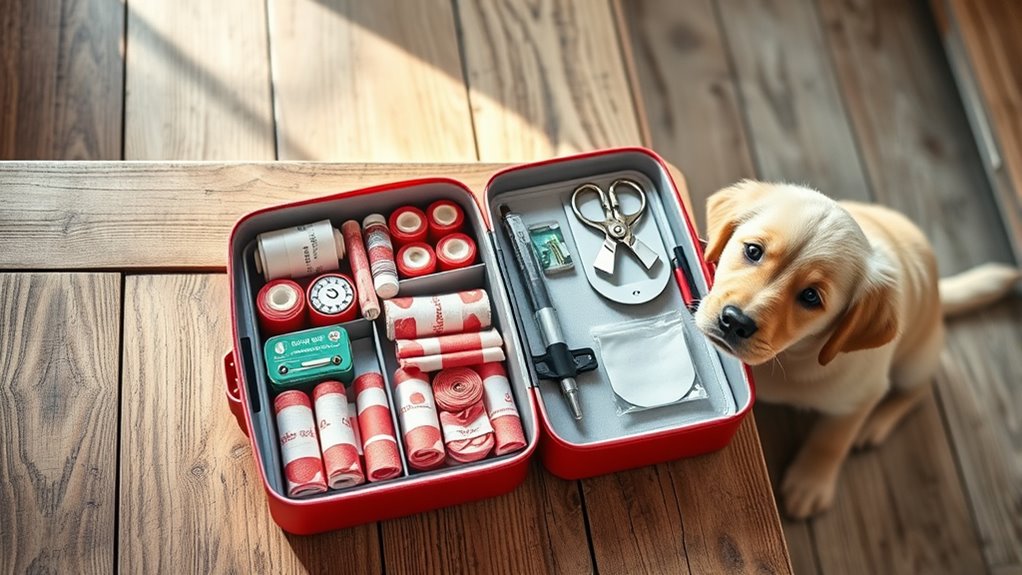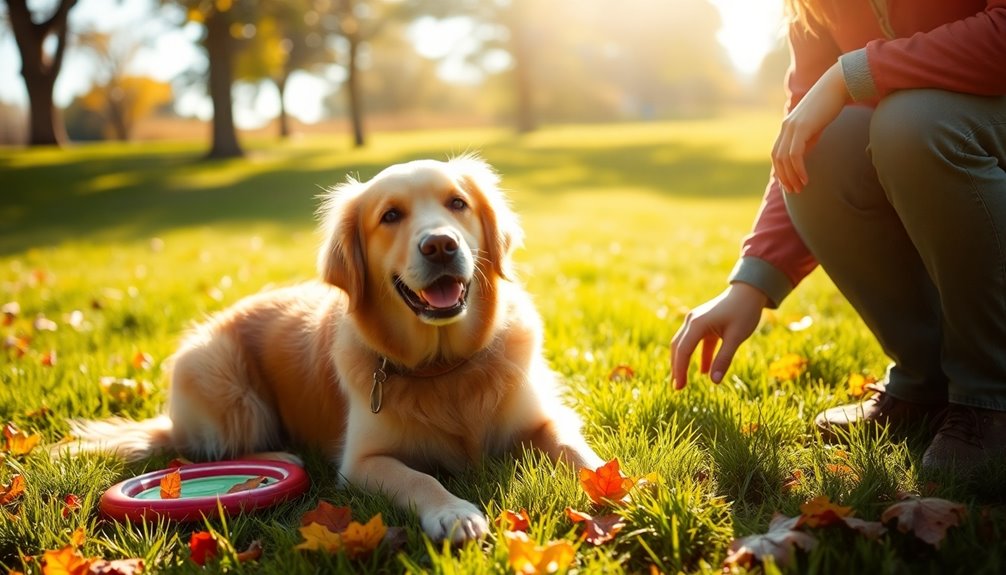To be prepared for emergencies, you need a first-aid kit with essentials like antiseptic wipes, gauze pads, adhesive tape, sterile gloves, and tweezers. Include scissors, antibacterial ointment, a digital thermometer, saline solution, and a clean towel for various situations. Keep emergency contacts for your vet, local clinics, and poison control handy. Staying organized and knowing how to utilize these supplies can make a real difference—continue for tips to ensure you’re fully ready.
Key Takeaways
- Stock antiseptic wipes, sterile gauze, adhesive tape, gloves, and tweezers for effective wound cleaning and management.
- Include antibacterial ointment, scissors, cone, and items for quick wound care to promote healing.
- Keep veterinarian, emergency clinics, and poison control contacts accessible in both physical and digital formats.
- Add a digital thermometer, saline solution, flashlight, and clean towels for comprehensive emergency response.
- Organize the kit for easy access, ensure supplies are sterile, and maintain knowledge of proper first-aid procedures.

Being prepared for emergencies is essential when caring for your dog, as accidents can happen unexpectedly. Having a well-stocked first-aid kit on hand can mean the difference between a minor issue and a serious problem. Start by making sure your kit includes basic supplies such as antiseptic wipes, gauze pads, adhesive tape, and sterile gloves. These items allow you to clean wounds properly and prevent infection. It’s also wise to include tweezers for removing splinters or debris and scissors to cut bandages to size. Remember, quick and effective wound care can greatly improve your dog’s recovery process.
Preventing injuries is just as important as treating them. Focus on dog bite prevention by using behavior cues and safe interactions, especially around unfamiliar dogs or during stressful situations. Keep your dog on a leash or in a secure area to minimize unexpected encounters that could lead to bites. Your first-aid kit should also contain items like antibacterial ointment to apply after a bite or scratch, along with a cone or protective gear if your dog tends to lick or bite at injuries. These precautions help avoid escalation and reduce the risk of infection.
In addition to physical supplies, your emergency contact list should be extensive. Include your veterinarian’s phone number, 24/7 emergency animal clinics, and the local poison control center that specializes in pet emergencies. Having these contacts readily available ensures you won’t waste precious time searching for help during a crisis. Keep a written copy in your first-aid kit and also store digital versions on your phone for quick access. Being able to reach professional assistance immediately can make a big difference, especially if your dog shows signs of severe distress or if you suspect poisoning.
Your first-aid kit should also have other essentials like a digital thermometer, saline solution for flushing wounds, and a clean towel for handling emergencies. Including a flashlight can be helpful if you need to examine your dog in low light conditions. Don’t forget to regularly check and replace supplies to make sure everything remains sterile and functional. Being proactive and organized can also involve understanding home theatre projectors, which can be useful if you want to create a comfortable space for your pet to relax during recovery. By being proactive and organized, you prepare yourself to handle unexpected situations confidently. With the right supplies, knowledge, and contacts, you lessen stress and improve outcomes for your furry friend when accidents happen. Remember, being prepared isn’t just about having supplies; it’s about knowing how to use them and having quick access to professional help when needed.
Frequently Asked Questions
How Often Should I Update My Dog’S First-Aid Kit?
You should update your dog’s first-aid kit regularly to guarantee it’s always ready. Seasonal updates are important, as your dog’s needs may change with weather and activities. After trips or travel, check supplies and restock essentials. Also, review the kit annually or whenever you notice items are expired or used. Staying proactive helps you stay prepared for emergencies, making your dog’s safety a top priority.
Can I Use Human First-Aid Supplies on Dogs?
You might wonder if human supplies are safe for your dog, but it’s best to avoid using them without veterinary advice. Human medication safety differs greatly from what’s safe for dogs, and some items can be toxic. Always keep your vet’s contact info handy and stick to dog-specific first-aid supplies. Using proper, vet-approved products guarantees your dog’s safety and helps prevent accidental harm.
What Should I Do if My Dog Ingests a Toxic Substance?
Did you know that over 100,000 pets are hospitalized annually due to toxic substance ingestion? If your dog eats something toxic, stay calm and act quickly. Call your veterinarian or emergency contacts immediately. Do not try to induce vomiting unless advised by a professional. Keep your pet comfortable and avoid giving food or water unless instructed. Prompt action can make a huge difference in your dog’s recovery.
How Do I Handle a Broken or Fractured Bone in My Dog?
If your dog has a broken or fractured bone, you should stay calm and avoid moving them too much. Handle bone injuries carefully and perform emergency immobilization if possible, like splinting the limb without forcing it. Keep your dog still and prevent any unnecessary movement. Seek veterinary help immediately, as prompt professional care is essential for proper treatment and healing. Your quick action can make a big difference in their recovery.
Are There Any Breed-Specific First-Aid Considerations?
When addressing breed-specific injuries, you should be aware that some breeds are prone to breed-related symptoms that require special attention. For example, brachycephalic breeds may struggle with breathing issues during emergencies, while large breeds are more prone to fractures. Always tailor your first-aid approach to your dog’s breed, recognizing breed-related symptoms early. Keep a first-aid kit stocked with breed-specific supplies and consult your vet for tailored advice.
Conclusion
With these essentials packed, you’re prepared to be your dog’s hero, much like a knight ready for battle. Just as a seasoned adventurer trusts their map and gear, trust your first-aid kit to handle unexpected injuries. Remember, your quick action can turn a potential crisis into a minor bump in the road. Stay vigilant, stay prepared—your dog’s safety is in your hands, and every moment counts when you’re their greatest protector.










